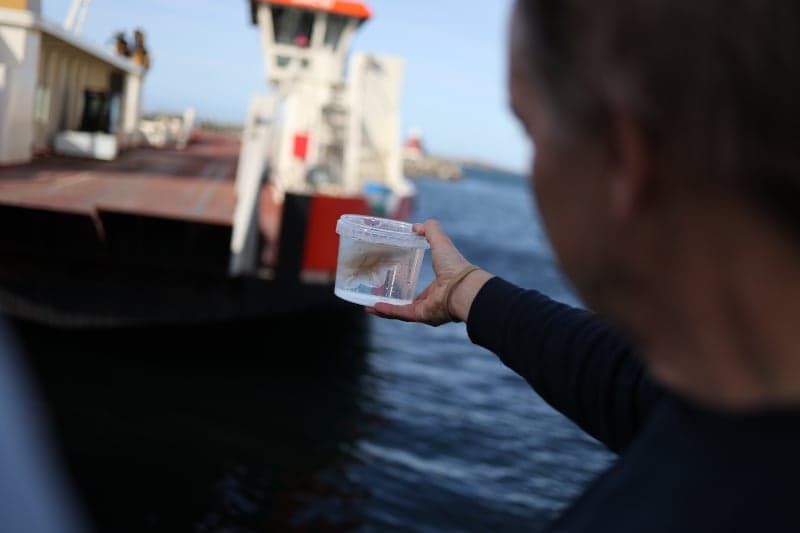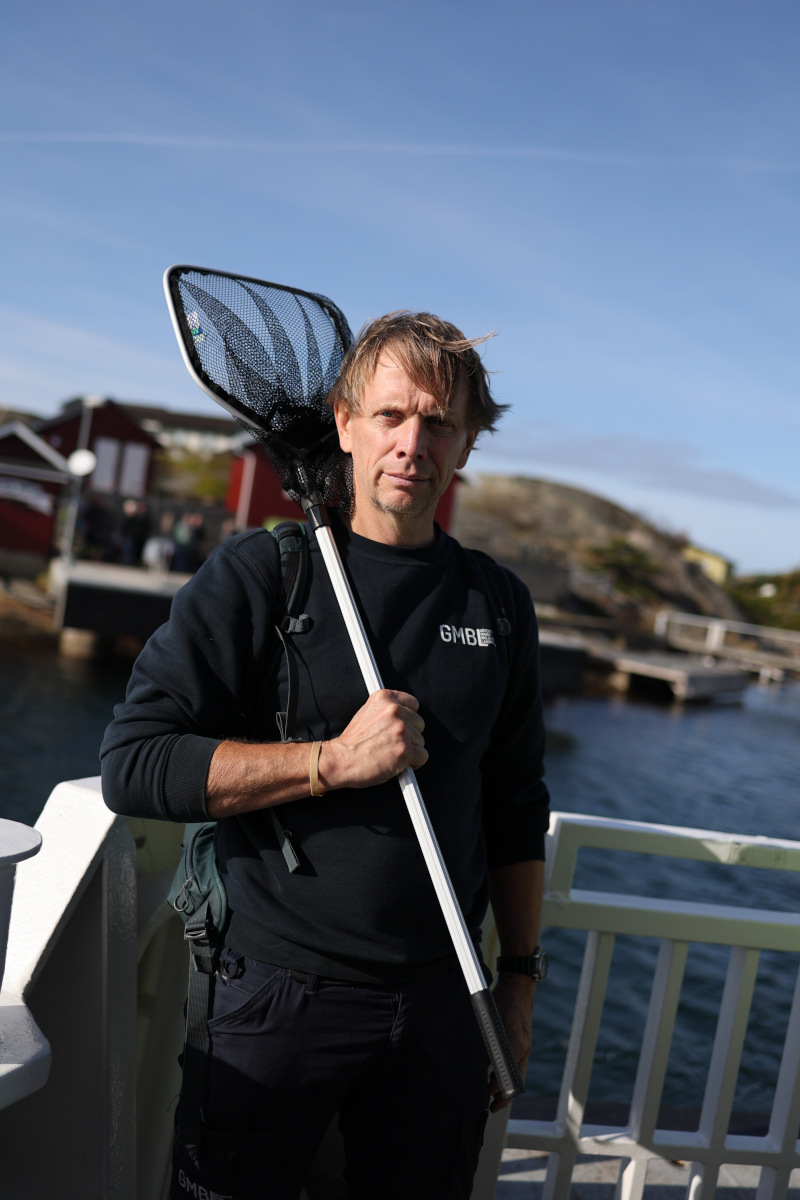How jellyfish in Gothenburg's archipelago reveal impact of climate change

A global increase in jellyfish sparked by climate change is impacting communities in the Gothenburg archipelago, with local restaurants and fishing reporting the effects.
Jellyfish numbers are rising globally because of climate change and human impact on the marine environment, with the worrying trend set to continue.
Researchers report an increase in comb jellies in Swedish waters along with the 2018 arrival of an “alien species” called the clinging jellyfish, which delivers a painful sting.
But they warn there is not enough research to understand the full extent of their impact and further consequences at a local level.
To uncover the extent of the increased amount of jellyfish in the local environment, the writers of this article headed to Vrångö island with Björn Källström, a marine biologist at the University of Gothenburg. We didn't have to search for long: jellyfish are visible both in the water and on land.

Marine biologist Björn Källström reports that human activity is responsible for the rise in jellyfish. Photo: Peter Seenan
When our team captured an American comb jellyfish, Källström commented: “This is an invasive alien species, which arrived in Swedish waters in 2006. In summer, people in Sweden report thousands of them.”
Aside from reducing the amount of fish in the sea, jellyfish clog nets.
"When fishing mackerel, we can’t catch anything," Andreas Olsson Wijk, a local fisherman, said. "[The jellyfish] fill the net and it’s impossible to get anything into the boat.”

Fisherman and restaurateur Andreas Olsson Wijk says jellyfish prevent the catching of mackerel. Photo: Peter Seenan
According to Håkan Karlsten, a local hotel owner who has lived on the island permanently since 1991, “small fishing boats have problems because they are not strong enough to take anything. They don’t have tools to take them out, or strong motors to counteract the weight of the jellyfish in the nets.”
Professor Lena Granhag, lecturer of Maritime Studies at Chalmers University, explained that the warming of sea waters, caused by climate change, leads to the presence of the American comb jellyfish in Sweden and the Baltic Sea.
Excessive levels of nutrients in the water, called eutrophication, also contribute to the growth of the jellyfish population. The main nutrients involved in this process are nitrogen and phosphorus, which can be found in farming pesticides and fertilisers.
“More nutrients will lead to more blooms,” she said. “When there are lots of nutrients, algae will bloom. Jellyfish can eat the algae directly, but they actually capture zooplankton – or small shrimp – that in turn have algae on them.”
Källström explained how direct human action is also relevant. Ships can be responsible for introducing other invasive species, like the clinging jellyfish, which “came in 2018 with a big cargo ship to Swedish waters and managed to survive”.
Overfishing is also “a factor leading to more jellyfish”, he added, since fish are one of their main predators.

A jellyfish, or 'manet' as they are called in Swedish. Photo: Peter Seenan
Increasing jellyfish are a global trend. Along the coast of Haifa in Israel, jellyfish cause a lot of damage every year, with this increasing in the last few years. The Society of Ecology and Environmental Sciences in Israel points to climate change as a cause, with overfishing and the farming sector part of the reason behind the altered ecosystem.
Jellyfish blooms can also pose practical challenges, such as clogging the cooling water streams of nuclear power plants. Reactors at Sweden's Oskarshamn nuclear power plant were clogged in 2005 and 2013. It happens regularly at Japan’s nuclear power plants during the summer in a tsunami-stressed energy sector. Nuclear power plants in Scotland face a similar challenge.
“The problem in Sweden and in many other places is that we don’t have any long-term series of measurements of monitoring jellyfish. It’s actually quite difficult to say for any place in Sweden or many places in the world that jellyfish are in fact increasing. However, there are several signs of increase,” Källström said.

Jellyfish at Vrångö where locals say they are causing problems for fishing. Photo: Peter Seenan
A deeper understanding for the increase of jellyfish and their link with climate change depends on greater economic investment in the collection of data and marine research.
Initiatives on crowd-sourced data, such as the reports by the Swedish Agency for Marine and Water Management, are one solution to the lack of research about jellyfish numbers and its relation to climate change. “This is citizen science, people are helping scientists,” Källström said.
Global trends suggest the impact of jellyfish goes beyond stung tourists and clogged nuclear power plants, to affecting local economies, marine ecosystems and local food production – an unsettling indicator of human action and its consequences for our climate that local actors and the international community fail to address.
Article by Gothenburg University students Sandra Daniel, Mireia Jimenez Barcelo, Javad Maleki, Peter Seenan and Marina Panicheva
Comments
See Also
Jellyfish numbers are rising globally because of climate change and human impact on the marine environment, with the worrying trend set to continue.
Researchers report an increase in comb jellies in Swedish waters along with the 2018 arrival of an “alien species” called the clinging jellyfish, which delivers a painful sting.
But they warn there is not enough research to understand the full extent of their impact and further consequences at a local level.
To uncover the extent of the increased amount of jellyfish in the local environment, the writers of this article headed to Vrångö island with Björn Källström, a marine biologist at the University of Gothenburg. We didn't have to search for long: jellyfish are visible both in the water and on land.

When our team captured an American comb jellyfish, Källström commented: “This is an invasive alien species, which arrived in Swedish waters in 2006. In summer, people in Sweden report thousands of them.”
Aside from reducing the amount of fish in the sea, jellyfish clog nets.
"When fishing mackerel, we can’t catch anything," Andreas Olsson Wijk, a local fisherman, said. "[The jellyfish] fill the net and it’s impossible to get anything into the boat.”

According to Håkan Karlsten, a local hotel owner who has lived on the island permanently since 1991, “small fishing boats have problems because they are not strong enough to take anything. They don’t have tools to take them out, or strong motors to counteract the weight of the jellyfish in the nets.”
Professor Lena Granhag, lecturer of Maritime Studies at Chalmers University, explained that the warming of sea waters, caused by climate change, leads to the presence of the American comb jellyfish in Sweden and the Baltic Sea.
Excessive levels of nutrients in the water, called eutrophication, also contribute to the growth of the jellyfish population. The main nutrients involved in this process are nitrogen and phosphorus, which can be found in farming pesticides and fertilisers.
“More nutrients will lead to more blooms,” she said. “When there are lots of nutrients, algae will bloom. Jellyfish can eat the algae directly, but they actually capture zooplankton – or small shrimp – that in turn have algae on them.”
Källström explained how direct human action is also relevant. Ships can be responsible for introducing other invasive species, like the clinging jellyfish, which “came in 2018 with a big cargo ship to Swedish waters and managed to survive”.
Overfishing is also “a factor leading to more jellyfish”, he added, since fish are one of their main predators.

Increasing jellyfish are a global trend. Along the coast of Haifa in Israel, jellyfish cause a lot of damage every year, with this increasing in the last few years. The Society of Ecology and Environmental Sciences in Israel points to climate change as a cause, with overfishing and the farming sector part of the reason behind the altered ecosystem.
Jellyfish blooms can also pose practical challenges, such as clogging the cooling water streams of nuclear power plants. Reactors at Sweden's Oskarshamn nuclear power plant were clogged in 2005 and 2013. It happens regularly at Japan’s nuclear power plants during the summer in a tsunami-stressed energy sector. Nuclear power plants in Scotland face a similar challenge.
“The problem in Sweden and in many other places is that we don’t have any long-term series of measurements of monitoring jellyfish. It’s actually quite difficult to say for any place in Sweden or many places in the world that jellyfish are in fact increasing. However, there are several signs of increase,” Källström said.

A deeper understanding for the increase of jellyfish and their link with climate change depends on greater economic investment in the collection of data and marine research.
Initiatives on crowd-sourced data, such as the reports by the Swedish Agency for Marine and Water Management, are one solution to the lack of research about jellyfish numbers and its relation to climate change. “This is citizen science, people are helping scientists,” Källström said.
Global trends suggest the impact of jellyfish goes beyond stung tourists and clogged nuclear power plants, to affecting local economies, marine ecosystems and local food production – an unsettling indicator of human action and its consequences for our climate that local actors and the international community fail to address.
Article by Gothenburg University students Sandra Daniel, Mireia Jimenez Barcelo, Javad Maleki, Peter Seenan and Marina Panicheva
Join the conversation in our comments section below. Share your own views and experience and if you have a question or suggestion for our journalists then email us at [email protected].
Please keep comments civil, constructive and on topic – and make sure to read our terms of use before getting involved.
Please log in here to leave a comment.